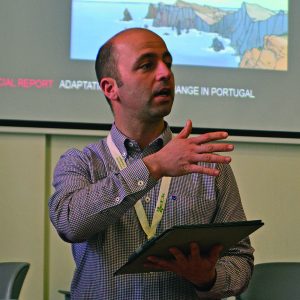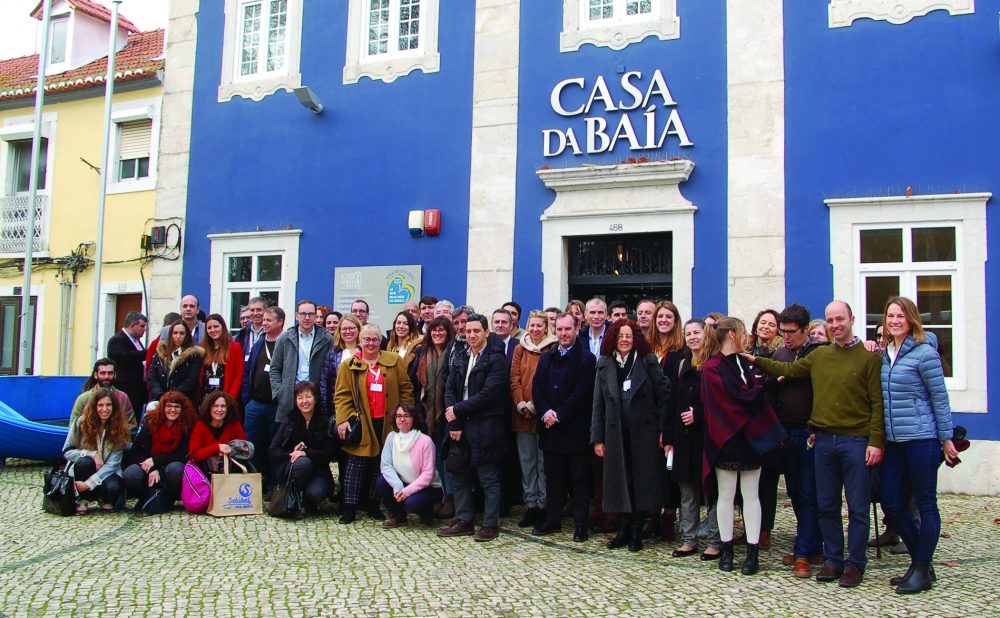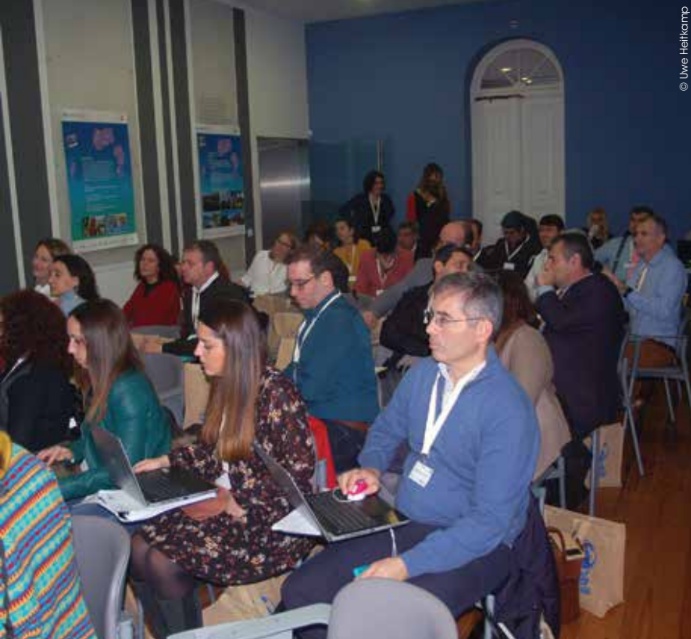Municipalities and local representatives can be pioneers and drivers of deep decarbonisation and profound social transformation. This is the firm belief of BEACON, or “Bridging European and Local Climate Action”. The European project seeks to promote climate action, co-operation and learning amongst municipal representatives and the dissemination of good practices – in order to implement the Paris Agreement and the targets for 2030. Financed by Germany (the European country with the highest emissions and the sixth highest worldwide), in Portugal the project involves five municipalities and is coordinated by the Centre for Ecology, Evolution and Environmental Changes – cE3c (Faculty of Sciences of the University of Lisbon – FCUL) and the Institute of Social Sciences. Gil Penha-Lopes, a researcher at cE3c and one of the coordinators of the project, tells us what is already being done and what still remains to be done.

You have been studying climate change since 2011. What scenario are we facing today?
A few years ago, new scenarios began to emerge, with their different possibilities. We should obviously be continuing with the scenario of reaching a peak of emissions by 2030 and then starting to reduce them. That is, until then, we should be creating all the necessary infrastructures, behavioural changes, etc., that will be needed to have a more sustainable life and a strong reduction in our emissions thereafter.
All other scenarios are a little more pessimistic. Scenarios in which we can’t manage to change people’s behaviour, and models in which we have a reduction of emissions with no reference to staying below 1.5°C to 2°C by the end of the century. And scenarios that maintain a business as usual stance, with an increase in emissions until well after 2050. This is the most pessimistic scenario: we’re talking about a planet which will be six to eight degrees warmer by the end of the century. At its most positive, we’re talking about staying less than 1.5° warmer. All this is measured in relation to the pre-industrial era, in the mid-eighteenth century.
I think we’re heading for a world that is about four to five degrees warmer, which is already highly disastrous for our generation and future generations. We’re talking about a world with a greater number and intensity of extreme events, such as hurricanes and torrential rain, with monsoons in different parts of the globe. Prolonged drought in some places, floods in others.
All this creates disruption throughout the global system, which is not very resilient. It leads to rising food prices, and a lack of food in some places. Species cannot keep pace with these changes, so we’re also talking about a great loss of biodiversity, much of which is associated with what we need, such as food. I’m talking about bees and insects, etc.
Are our local authorities and their populations concerned about the issue?
There’s already a lot going on at a local level. I see many companies and municipalities wanting to change. The point is that we’re talking about a reduction in greenhouse gas emissions that is greater than 40%. It’s no longer just the simple reduction of 5 to 10%, which we can sometimes achieve by making systems a little bit more efficient, etc.
We’re talking about a need for systemic transformation: the way we live, how we interact with the rest of the environment, how we work… The need to move from one place to another. The whole way we produce and transport food.
We must rethink all of this and try not to keep it all going, but be a little more efficient – an area on which our discussion still appears to be centred a lot of the time. Take transport, for example. Obviously, the solution isn’t that everyone gives up their petrol or diesel car for an electric car right now! This completely destroys all the intentions of reducing emissions, because a large part of the emissions we make is caused by the production of new vehicles, especially those that have batteries.
And yes, switch to electric vehicles powered by renewables – mostly being fed by what is in the network – and they will be totally public, thus greatly reducing the need for transport.
I think we’re still a long way off. Maybe it will only happen when we start to feel the great impact of extreme events, rising sea levels, changes in seasons, decreases in the amount of rain falling over a year, so that we have problems of reservoirs and dams with far less water.
Then, even if we start doing things, the whole natural system will take a period of several decades, maybe hundreds of years, to recover. So, it doesn’t end from one day to the next, because it didn’t start from one day to the next.
And by then it will probably be too late.
What is the importance of establishing municipal strategies for adaptation?
It’s crucial that we already start to implement mitigation at a local level. We’re talking about emission reductions ranging from 40 to 80%, and all the time there is a greater amount of carbon to sequester – coming from all the organic waste not sent to landfill and managed in such a way as to create good soil at a local level. After that, we need to create ecosystems that are much more productive in terms of biodiversity. Avoiding those monocultures that each municipality has and turning them into a highly dense agro-forest. Capturing all this carbon in biomass and soil.
We need to move around less and to produce greater quantities of food locally, consuming food that is in season.
We should avoid using cars, promoting the bicycle, making homes that are better constructed, with insulation, green roofs, etc. All this leads to increased costs and it’s important that this happens without social exclusion.
From the point of view of adaptation, it’s important that the municipalities understand the impacts that are occurring locally and those which will tend to become more intense. We’re experiencing more heat waves, and for longer periods. There’s a smaller amount of water, and rain, when it comes, is more torrential. We must have a greater capacity both in our ecosystems and in the infrastructures, leading to a better absorption of rain by the soil, and greater water collection in the dams etc., because with the risk of everything going out to sea, there are going to be urban floods and landslidesMunicipalities creating more sustainable energy production is also a form of adaptation, because we don’t know if other countries will be able to sell us energy.
Nature-based design techniques, such as agro-forestry, are a way of solving many of these issues at the same time. Soils, food production, building materials, capturing carbon and being better able to adapt.

The BEACON team brings together people from the natural and social sciences to support this process …
First, there was the local Climate-ADAPT project, which developed adaptation strategies for 26 municipalities in Portugal, and which can be found at climadapt-local.pt
The BEACON project has strengthened the need for CO2 mitigation. Because it can actually be adopted without mitigation – by consuming more energy and sending more greenhouse gases into the atmosphere! We must bring back the awareness that, whatever we do, mitigation must be a priority. Because, if we solve the problem right from the start, we avoid having to adapt so much.
It’s funded by the German Ministry for the Environment and seeks to bridge the gap between European mitigation strategies and the municipalities themselves by creating a municipal network in Europe, above all bridging the gap between south, east and central Europe. We want to enable municipalities to establish and implement their own strategies, mainly in the energy sector, from production to distribution and consumption.
What are the biggest limitations to real changes?
Faced with reality, there are always ways to overcome any limitations. What is important is that changes are made in a participatory fashion. I know it may take longer, but it’ll have a much greater impact.
There are some regional and national laws and policies that can’t be supported, as is the case with the energy communities in Portugal. But that’s the way we’re doing it. Changing the words “rubbish” and “organic waste” in legal terms to “resources” was very helpful. And we use the local organic resources that are wasted to nourish local ecological needs. In some cases, there is already the knowledge and dynamism that can be identified at a local level and which can be brought into play at the national level, ensuring that a change can take place. I don’t see many limitations, especially given the urgency of the situation.
Since Kyoto, we’ve been seeing policymakers setting goals and not meeting them. A mismatch between the discourse of sustainability and the practice of increasing emissions and the destruction of ecosystems. Local political life is full of electoral campaigns, nepotism and corruption. Are local councils aware of what is happening? Can we count on them for real changes?
I would say we have no other choice. And, if the mayors don’t do it, civil society must become much more active and participatory and not just vote every four years.
There is a difference between the mayor wanting to do things and all the rest of the system, with which the municipality has to interact in order to implement its proposals.
We have cases where the mayors have been deeply involved in the project, such as in Loulé or Viana do Castelo. And actions have followed words. The mayor of Loulé was with us during four hours of a workshop, and he brought with him the deputy mayor, six councillors, the presidents of the municipal water companies, departmental workers, etc. There are two municipal technicians doing their doctoral programme on climate change and sustainable development. It is a prime example of proactive municipal leadership.
What are the highlights from these two days of workshops? What gave you most encouragement?
It allowed us, the southern European team, the Portuguese and the Greeks, and the German team, to work together and better understand the local reality. It gave the technicians time to leave their environments and to spend two days working just on this theme alone. Looking at examples, gaining inspiration, exchanging contacts. Often, we’re isolated and not connected with other realities, and we can’t think outside the box.
What inspiring projects did you see in these municipalities?
There were several. Mostly from Germany, where much more time has already been spent on this. The municipalities there have made their infrastructures environmentally friendly, saving a lot of energy. They promote public and collective transport, bus passes, season tickets and other similar things. They provide allotments, encouraging more sustainable food production through markets. They foster more sustainable behaviour in people’s homes, through financial grants or a reduction in taxes. Many municipalities produce and sell their own energy, or promote neighbourhoods that produce and consume their own energy, but they also sell it to the grid as well as to other neighbourhoods and other consumers, fostering a much more decentralised and fairer management of resources. We saw some very good examples.
Thank you.
 Eco123 Revista da Economia e Ecologia
Eco123 Revista da Economia e Ecologia


